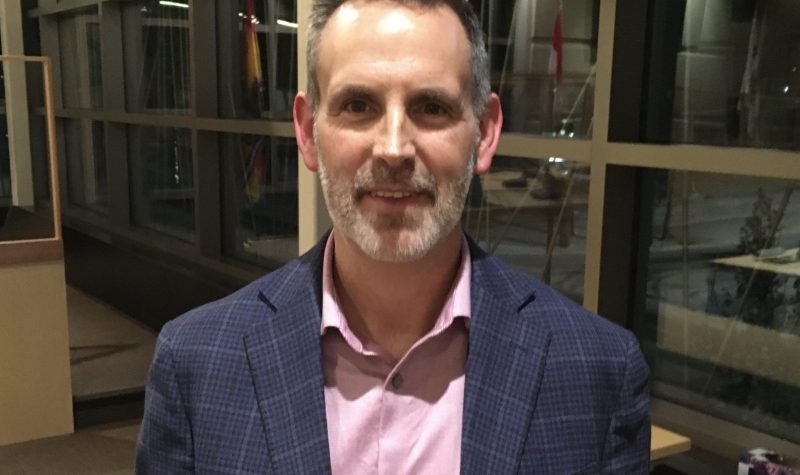Tantramar mayor Andrew Black has been talking about the Chignecto Isthmus a lot lately. In the mayor’s report at last week’s committee of the whole meeting, Black mentioned conversations with his counterparts in the Federation of Canadian Municipalities, with an insurance executive concerned about reducing risk, and with former Sackville councillor and ClimAtlantic director Sabine Dietz, about hosting a discussion on how to protect the important transportation corridor between New Brunswick and Nova Scotia from the effects of climate change, especially flooding.
Closing the information gap on the isthmus
Black told council last week that he and Mayor David Kogon of Amherst had met with ClimAtlantic’s Dietz to talk about an information sharing gap when it comes to the isthmus protection project.
In 2019, the province commissioned Wood Canada to study the isthmus and come up with options to protect it from rising sea levels and increasing frequency of severe storm events. That study was finally released in 2022, and the cost estimates it put forward have already more than doubled. Black says there’s more information out there, and considering that actual work on the isthmus is still years away, there’s plenty to discuss. Dietz has proposed a session involving municipal, provincial and federal representatives and various experts on how to protect the isthmus, and has asked the councils in Tantramar and Amherst for letters of support.
“The Wood study is fairly complete, but it’s not complete,” says Black. And by the time the project actually sees shovels in the ground, he says, the project “might not look the way that it’s presented in the Wood study.”
“Maybe it’s not just simply a matter of slapping up a giant gate, or shoring up existing dikes with piles and piles of shale,” says Black. “There’s going to be lots of further conversation and research to get to the point where there’s a shovel in the ground. So bringing people together into a room to discuss some of these things, and to talk to people about approaches to the Chignecto Isthmus is a really good thing to happen right now.”
Tantramar council will consider whether or not to support ClimAtlantic’s proposal once the matter is formalized in a motion, possibly at their August 8 meeting. Black says the meeting won’t cost the municipality anything, and has suggested that the meeting might be hosted in Point de Bute, due to its proximity to the Isthmus.
FCM resolution and a new minister of infrastructure
Black has also been talking about the Chignecto Isthmus around the Atlantic Caucus table of the Federation of Canadian Municipalities (FCM). After some discussion, a resolution is making its way through the national organization calling for greater federal investment on climate-related protection projects.
“It’s not specifically advocating on behalf of the Chignecto Isthmus,” says Black, “but it is using that particularly vulnerable piece of land as a clear example of something that needs to get fixed within the country. And there are other areas in the country that are like this, that would also benefit from increased funding opportunity.”
On July 19, after much back and forth, Nova Scotia and New Brunswick did finally apply to the federal government’s Disaster Mitigation and Adaptation Fund (DMAF) to cover 50% of the estimated project cost of $650 million.
But the federal DMAF sets aside just $1 billion for disaster adaptation and mitigation, and an approval on the isthmus protection project would eat up nearly a third of the national fund. It’s a problem that former infrastructure minister Dominic LeBlanc pointed out at a news conference before he was shuffled out of the infrastructure posting. Nova Scotia MP Sean Fraser now sits as minister of Housing, Infrastructure and Communities.
Black says he hopes the switch in ministers won’t delay the process for the Isthmus project. “The DMAF is there, it has its mandate,” says Black. “And as long as the Minister is following that, then everything should continue to flow.”
“We’ll keep pushing as much as we can, says Black, acknowledging that the municipal level of government does not have the power or resources to address the problem on its own. “Mayor Kogon and I spoke about this recently, where there’s only so much we can do as mayors of two small little municipalities with the unfortunate position of having the Bay of Fundy and the Chignecto Isthmus right in our front door,” says Black. “We can [push] as hard as we want with ministers of transportation and infrastructurs, departments of natural resources, our premiers… We can continue to do that and advocate, but once it gets to a certain point, it’s in other people’s hands. So all we can do is just continue to push.”
Private investment on climate adaptation?
Black also arranged a meeting to talk about the isthmus with Kogon and Don Iveson, a former Edmonton mayor and executive advisor in climate investing and community resilience with Cooperators Insurance. Black heard Iveson and his team present at an FCM conference earlier this year. “They were mentioning the insurance companies being interested in or concerned about particular climate change adaptation mitigation projects,” says Black. “If there was an opportunity for an insurance company or a big firm to get involved in funding a project that may then alleviate insurance claims, then this is something that they were interested in pursuing.”
Black says the meeting was informational, with the Chignecto mayors sharing the history and current threats to the Isthmus, along with the proposed engineering solutions, with the Cooperators team. Black points out that the potential for insurance claims in the event of dykes breaching on the Bay of Fundy is “astronomical”.
“So if there was an opportunity, arguably, for private investment, particularly through the insurance companies, to get involved in seeing a project done that would stop those insurance claims, then it seems to make sense for that company to do so,” says Black.


